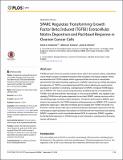Files in this item
SPARC regulates transforming growth factor beta induced (TGFBI) extracellular matrix deposition and paclitaxel response in ovarian cancer cells
Item metadata
| dc.contributor.author | Tumbarello, David A. | |
| dc.contributor.author | Andrews, Melissa R. | |
| dc.contributor.author | Brenton, James D. | |
| dc.date.accessioned | 2016-09-14T09:30:13Z | |
| dc.date.available | 2016-09-14T09:30:13Z | |
| dc.date.issued | 2016-09-13 | |
| dc.identifier | 245528072 | |
| dc.identifier | 3cd897f8-d35b-4128-b8d4-6dc672afd9aa | |
| dc.identifier | 84990925135 | |
| dc.identifier | 000383681000048 | |
| dc.identifier.citation | Tumbarello , D A , Andrews , M R & Brenton , J D 2016 , ' SPARC regulates transforming growth factor beta induced (TGFBI) extracellular matrix deposition and paclitaxel response in ovarian cancer cells ' , PLoS ONE , vol. 11 , no. 9 , e0162698 . https://doi.org/10.1371/journal.pone.0162698 | en |
| dc.identifier.issn | 1932-6203 | |
| dc.identifier.uri | https://hdl.handle.net/10023/9495 | |
| dc.description | This work was supported by Cancer Research UK and the University of Cambridge. | en |
| dc.description.abstract | TGFBI has been shown to sensitize ovarian cancer cells to the cytotoxic effects of paclitaxel via an integrin receptor-mediated mechanism that modulates microtubule stability. Herein, we determine that TGFBI localizes within organized fibrillar structures in mesothelial-derived ECM. We determined that suppression of SPARC expression by shRNA decreased the deposition of TGFBI in mesothelial-derived ECM, without affecting its overall protein expression or secretion. Conversely, overexpression of SPARC increased TGFBI deposition. A SPARC-YFP fusion construct expressed by the Met5a cell line co-localized with TGFBI in the cell-derived ECM. Interestingly, in vitro produced SPARC was capable of precipitating TGFBI from cell lysates dependent on an intact SPARC carboxy-terminus with in vitro binding assays verifying a direct interaction. The last 37 amino acids of SPARC were shown to be required for the TGFBI interaction while expression of a SPARC-YFP construct lacking this region (aa 1-256) did not interact and co-localize with TGFBI in the ECM. Furthermore, ovarian cancer cells have a reduced motility and decreased response to the chemotherapeutic agent paclitaxel when plated on ECM derived from mesothelial cells lacking SPARC compared to control mesothelial-derived ECM. In conclusion, SPARC regulates the fibrillar ECM deposition of TGFBI through a novel interaction, subsequently influencing cancer cell behavior. | |
| dc.format.extent | 20 | |
| dc.format.extent | 5606400 | |
| dc.language.iso | eng | |
| dc.relation.ispartof | PLoS ONE | en |
| dc.subject | QH426 Genetics | en |
| dc.subject | RC0254 Neoplasms. Tumors. Oncology (including Cancer) | en |
| dc.subject | NDAS | en |
| dc.subject | SDG 3 - Good Health and Well-being | en |
| dc.subject.lcc | QH426 | en |
| dc.subject.lcc | RC0254 | en |
| dc.title | SPARC regulates transforming growth factor beta induced (TGFBI) extracellular matrix deposition and paclitaxel response in ovarian cancer cells | en |
| dc.type | Journal article | en |
| dc.contributor.institution | University of St Andrews. School of Medicine | en |
| dc.identifier.doi | 10.1371/journal.pone.0162698 | |
| dc.description.status | Peer reviewed | en |
This item appears in the following Collection(s)
Items in the St Andrews Research Repository are protected by copyright, with all rights reserved, unless otherwise indicated.

